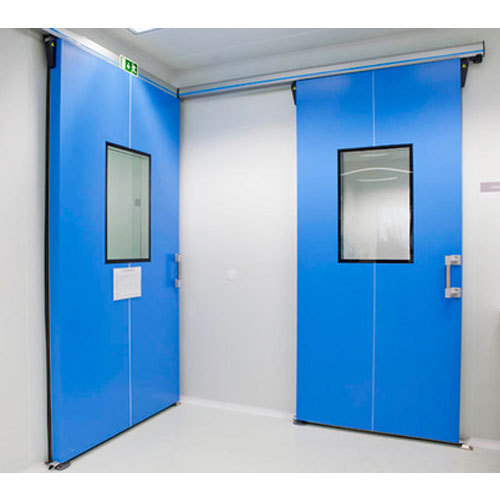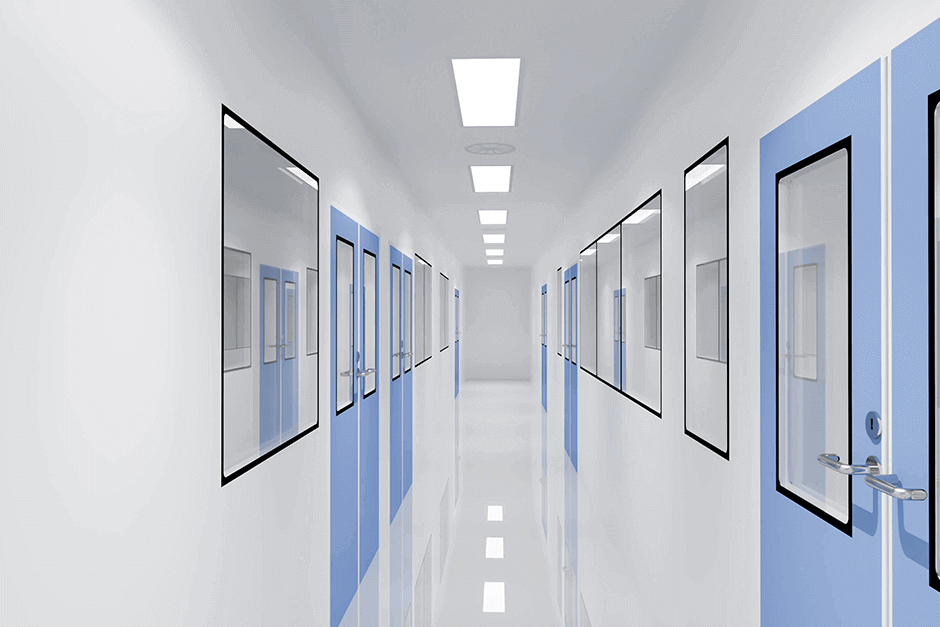Doors are the first thing you see when entering a clean room. Owner of Air and Surface Portals, Mr. Gregory Jones is focusing on your comfort. He knows that being in clean room means that you can’t be distracted by all kind of noise, bad smells, drafts and insects invading the interior. That is why he proposes to install doors which can have the following configuration:

Doors for clean rooms
Clean room doors are a critical component of clean rooms and class 100 laminar flow hoods.
Clean room doors are designed to keep airborne contaminants out of the clean room, while allowing access to people and equipment.
Clean room door hardware is typically stainless steel or aluminum. The door frame is usually welded or riveted, while the door is often hinged on the side opposite the hinges of the frame (for easier alignment). The door seals against a gasket that prevents dust from entering into the chamber.
Door hardware for pharmaceutical manufacturing applications include:
Pharma doors – Pharma doors are made with an extra thick seal for use in pharmaceutical drug manufacturing facilities where sterility is paramount. They are also used in other applications such as clean rooms, where contamination control is also important. Pharma doors have an extra layer of protection at their edge that provides additional protection from outside air infiltration, which can be especially important with long door runs when there are many points where contamination could enter a room through cracks or gaps in walls or ceilings elsewhere in the facility.
Hygienic doors – Hygienic doors provide a superior level of protection than standard clean room doors because they have a lower threshold for particle size than standard clean
Cleanroom door hardware is a critical component of the clean room environment. A clean room is a controlled environment that is kept free from contamination. Pharmaceutical companies use clean rooms to manufacture drugs and other pharmaceutical products. Many electronics manufacturers also use clean rooms to make computer chips, circuit boards, and other delicate electronics products. The air in these clean rooms must be filtered and purified to remove contaminants such as dust, dirt and bacteria so they don’t contaminate the products being made inside them.
Clean rooms typically have special doors that provide airtight seals between the outside of the room and inside it. These doors are often made of plastic or stainless steel so they can be easily cleaned if they become contaminated with particles from outside the room. They may have built-in filters on their sides to help keep dust out of the room during construction or installation.
There are many different types of clean room door hardware used in different industries:
Pharma doors: Pharma doors are designed specifically for pharmaceutical manufacturing facilities that require high levels of security for their products. They can include locks that verify identities before allowing anyone into the facility; keypads that require users to enter passcodes before entering; biometric readers (fingerprint or retina scanners); or even
The door is the most important part of the clean room. It has to be able to withstand the harsh environment and keep contamination out, while at the same time allowing easy access for personnel and equipment.
Door hardware for clean rooms must be able to withstand the high pressure of aseptic operations, which can reach up to 6 bar (90 psi). They must also be able to seal tight against bacteria or viruses that could contaminate the air inside the room. This makes them especially suitable for pharmaceutical companies and other industries where stringent requirements are needed for biohazard protection.
Clean rooms have many different types of doors depending on their purpose:
Mechanical doors – These doors are used when high energy saving is required, such as in food production or pharmaceutical industry applications. They are typically made from stainless steel or aluminum, with a double-skinned construction that improves insulation properties. The inner skin is usually insulated with polyurethane foam or aluminum foil laminated glasswool insulation boards (ALIG) and gas-tight silicone rubber seals around all edges for maximum sealing properties; mechanical door frames are usually made from aluminum extrusion profiles with a metal-to-metal seal system between frame parts.
Clean room doors are essential to the success of your clean room. They provide an air-tight seal, which is critical for the proper function of a clean room. If you don’t have an air-tight seal, then the contaminants will be able to seep in and contaminate the equipment and materials inside.
Clean room doors come in a variety of styles and sizes depending on the needs of your facility. There are standard doors, sliding doors and even double-swing doors that are available with different options for hardware and finishes.
Clean room door hardware includes the hinges, locks or latches and other hardware that can be used on these types of rooms. The hardware used for these kinds of doors should be able to withstand extreme temperatures as well as high humidity conditions. They should also be easy to clean so that they can be disinfected regularly (see our blog post on cleaning).
Clean rooms are used in a wide variety of industries, from pharmaceuticals to semiconductor manufacturing and electronics. Clean rooms must be designed to control the environment and prevent contamination. This means that clean room doors are an important part of the process, as they help keep the room sterile.
A clean room door is usually made from metal or plastic and has some type of sealing mechanism to prevent air from escaping or entering the room. The door should be designed for easy access by workers who need to enter and exit the room several times during their shifts.
The proper use of clean room doors can help ensure that your product stays uncontaminated and safe for use. The following are some types of clean room doors available:
Sliding Doors – Sliding doors are often used in laboratories because they allow users easy access to equipment while keeping dust out of the room. They can also be used in offices where privacy is important but air flow needs to be maintained within the space.
Roller Doors – Roller doors are often used in pharmaceuticals because they are easily cleaned and disinfected after each use, preventing cross-contamination between products. Roller doors can also be opened manually when necessary instead of requiring electricity or battery power like other types of clean room doors.

Hygienic doors
Clean room doors are typically made of stainless steel, but can be manufactured from other materials. The door hardware must withstand exposure to corrosive chemicals and oils, so stainless steel is the best choice. The door hardware must also be cleanable, which means that it should not be made of plastic or any other material that cannot be sterilized.
Pharmaceutical companies often have special requirements for their clean rooms and pharmaceutical storage facilities. For example, they may require a pharmaceutical type of clean room door that has features such as an air lock function and a double seal system that prevents contamination from outside sources. They may also need a specialized door handle that complies with the FDA’s Good Manufacturing Practices (GMP). A GMP compliant handle has a red dot on it to indicate that it meets these guidelines.
Clean room doors are made of stainless steel or aluminum to keep out contaminants. They have to be easy to clean, especially if they have to be opened and closed many times a day.
They are designed with smooth surfaces and rounded edges so that particles do not accumulate on their surface. The door opens toward the inside of the room, so that anyone entering the clean room will not bring outside contamination in with them.
Pharma doors are used in pharmaceutical manufacturing environments for safety reasons. They are made from stainless steel or aluminum and have smooth surfaces that are easy to clean. They also open towards the inside of the room so that no outside contaminants can enter when someone enters or leaves the room.
Hygienic doors are used in hospital operating rooms where sterile procedures must be followed at all times. These doors must be able to withstand repeated sterilization cycles without deterioration
Hygienic doors are used in clean rooms and pharmaceutical production facilities. These doors are designed to protect the integrity of the clean room environment by preventing contamination.
Clean room doors are constructed with materials that do not hold dirt or dust particles. Clean room doors must be kept clean and sanitized so they can continue to protect the clean room environment.
Clean room doors can be made of metal or plastic materials such as polyethylene or vinyl chloride. The choice of material depends on the application. In certain cases, it may be necessary to use both metal and plastic components in a single door assembly.
Typically, clean room doors have metal frames with a slight gap between the frame and door leaf for ventilation purposes. A sealant is used to close this gap to prevent dust from entering the room through this opening.
Hygienic doors are a very important part of any clean room. These doors are made from materials that will not scratch or spread any contamination. Hygienic door hardware has been specifically designed to meet the demands of clean rooms and laboratories.
Clean room door hardware is available in a variety of styles and finishes. We offer a wide selection of clean room door handles, hinges, locks, security latches and threshold protectors. You can also choose from various color options for your hygienic door hardware such as white or black to match your existing décor or create a striking new look for your office space.
Our hygienic doors are easy to install and maintain because they are made from durable materials that resist corrosion and fading over time while providing excellent airtight seals that help prevent contamination from dirt, dust and other contaminants that could damage sensitive equipment inside the laboratory environment.
We offer free samples so you can test our products before making a purchase decision to ensure they meet your needs exactly. Our expert team of customer service specialists is available 24/7 via phone or email with any questions you might have about our products or services so don’t hesitate to ask if you need assistance!
Hygienic doors are a specialized form of door that is used in clean rooms. These doors are designed to keep out contaminants and other unwanted particles, while allowing free movement of air within the room.
Clean rooms are typically found in manufacturing plants, hospitals, laboratories and pharmaceutical plants. The purpose of clean rooms is to reduce the risk of contamination during the production process.
Clean rooms contain equipment and machinery that produce sensitive products such as drugs or microchips. To create a clean environment in these facilities, it is necessary to maintain a certain level of purity within the room itself. This means that any foreign particles must be removed from the environment so that no contamination occurs during production.
Hygienic doors are one way to ensure that only air enters or leaves a clean room through its entrance or exit doors respectively. These doors have been specially designed so that they can be operated without exposing them directly to outside contaminants or particles from within the room itself.
